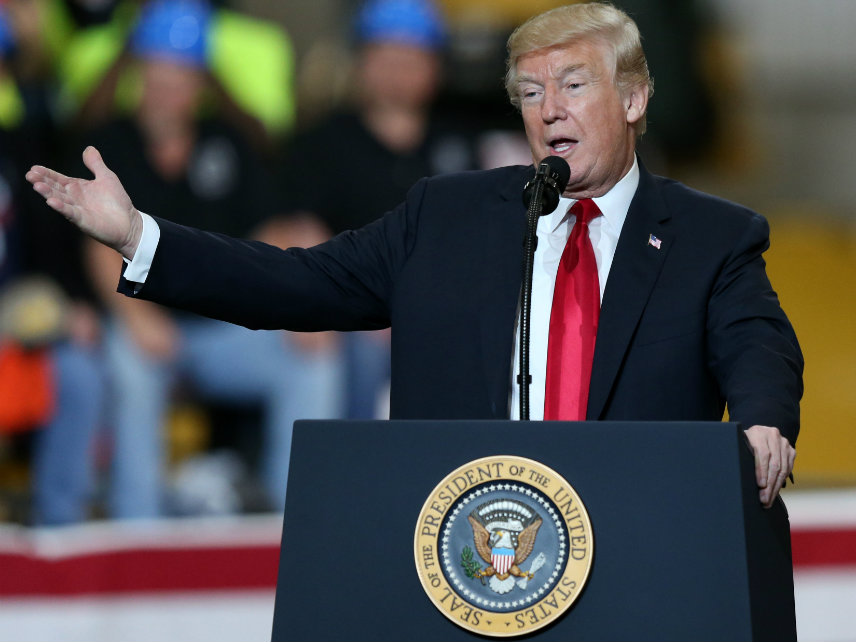White House Budget Calls for Domestic Spending Cuts, Military Spending Hikes, $8 Billion for Border Wall, Extension of Tax Cuts
The budget will take 15 years to balance and envisions trillion-dollar deficits through 2022, even with rosy economic assumptions.

President Donald Trump's newly unveiled budget proposal calls for spending even more money on the U.S. military and includes $8.6 billion for a border wall. It also aims to slash total non-military discretionary spending by 9 percent, but even with those cuts the budget would not balance in 10 years—the window within which presidents typically try to balance their spending plans, even if not realistically.
The White House claims its plan would balance the budget within 15 years—and that's only possible because the budget assumes 3 percent annual economic growth, a very rosy outlook. The budget projects trillion-dollar deficits until 2022.
Overall, the budget would spend $4.7 trillion during fiscal year 2020, which begins on October 1.
As I detailed last week, the budget plan attempts to skirt budget caps in order to increase military spending by $34 billion, bringing the Pentagon's budget to $750 billion. The Trump administration hopes to slip the spending increase into the uncapped budget designated for the military's so-called Overseas Contingency Operations, which fund America's foreign wars. It's an obvious gimmick that Congress should not accept.
Meanwhile, non-military discretionary spending would fall from $597 billion to $543 billion, a 9 percent cut. The Environmental Protection Agency (EPA) would face a 31 percent cut, the largest of any single department or agency, while the Department of State would see a 23 percent reduction.
If history is any guide, those cuts are not likely to pass. Last year, Trump called for cutting the Department of State's budget by 29 percent and the EPA's by 25 percent, but Congress instead agreed to a bipartisan budget plan that boosted domestic discretionary spending across the board (while also providing an increase for the Pentagon). And that was when the GOP controlled both houses of Congress. Now, of course, the Democrats hold the House of Representatives.
Trump signed that budget deal, but the White House is signaling that it will not look favorably on a similar dollar-for-dollar increase this year. Indeed, bipartisan spending increases are a reckless way to govern when the country is more than $22 trillion in debt, and so Trump deserves some credit for attempting to reduce spending in some areas. Still, it's difficult to see this budget proposal as a serious effort at curing Washington's fiscal problems.
Presidential budgets are always as much about politics as they are about financial planning—maybe more so. Trump's plan to boost the Pentagon's budget, to spend $8.6 billion on his much-promised border wall, and to extend the 2017 personal income tax cuts (which are scheduled to sunset in 2025) are attempts to play to his Republican base while the 2020 election is looming.
A few other highlights from the White House's budget proposal:
- Trump is proposing the creation of a new federal tax credit to promote school choice. The budget calls for Congress to approve up to $50 billion over 10 years in tax credits for donations to "scholarship programs for families of elementary and secondary students who are seeking state-defined public or private education options"—similar to some state-level school choice scholarship programs.
- The budget calls for new work requirements for federally funded welfare programs, including Medicaid. Able-bodied, working-age adults would have to "find employment, train for work, or volunteer (community service) in order to receive welfare benefits," the budget says. Along with other changes to federal welfare programs, the Trump budget aims to save $327 billion in welfare spending over 10 years.
- Infrastructure week is back! Trump's budget calls for $200 billion in new infrastructure spending, though White House officials say they are deliberately not offering many specifics on how the funding should be used and hope to work with Congress on that front. In a budget that will likely face much opposition from House Democrats, Trump apparently plans to use infrastructure spending as negotiating leverage.
- Among the few non-military discretionary programs getting a major boost in Trump's new budget is the Department of Homeland Security, which is earmarked for a $3.7 billion (7.8 percent) increase. Some of that new spending—$506 million of it, to be precise—would be used to hire an estimated 2,800 additional law enforcement officers and critical support personnel at U.S. Customs and Border Protection and U.S. Immigration and Customs Enforcement.


Show Comments (33)